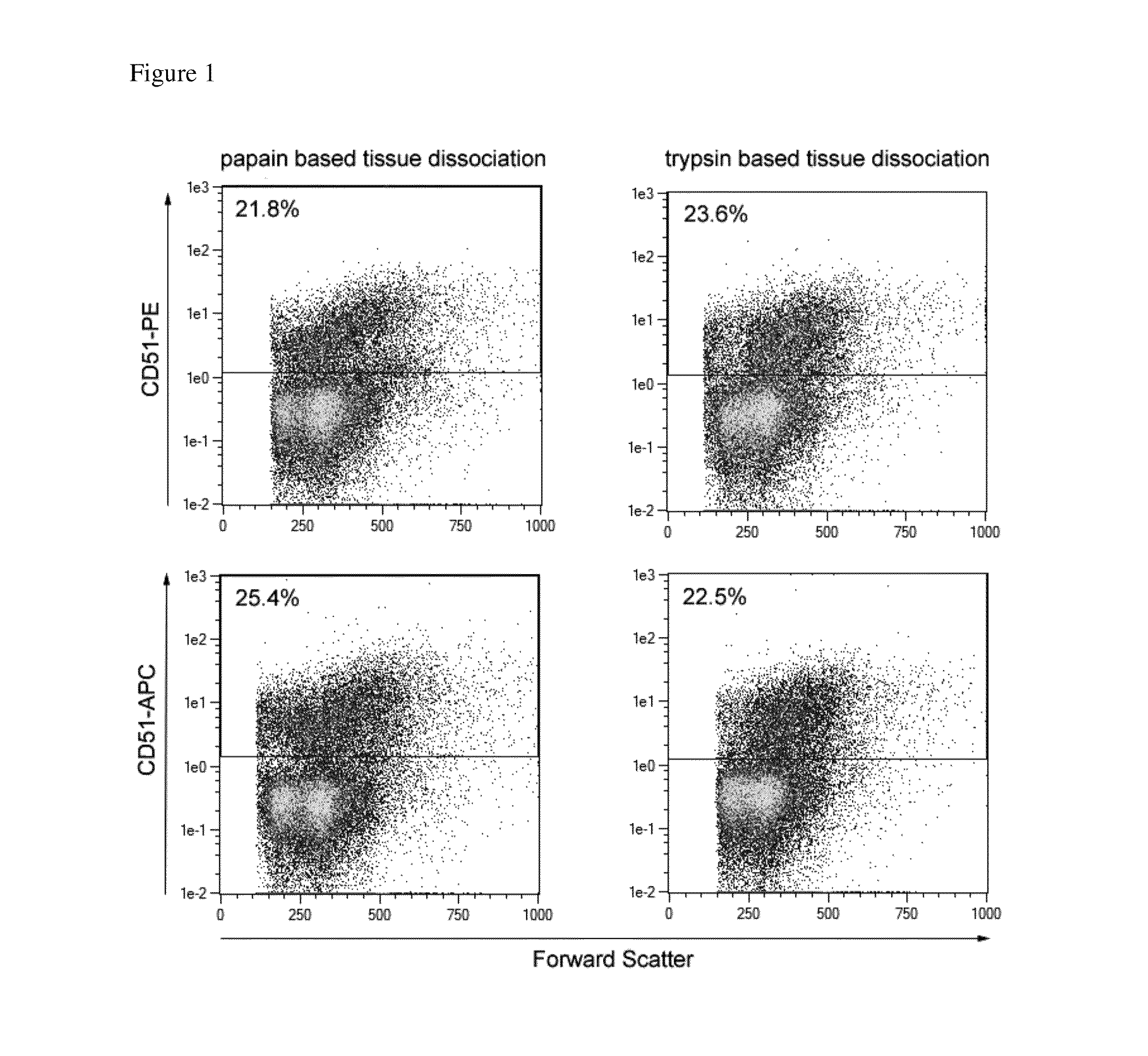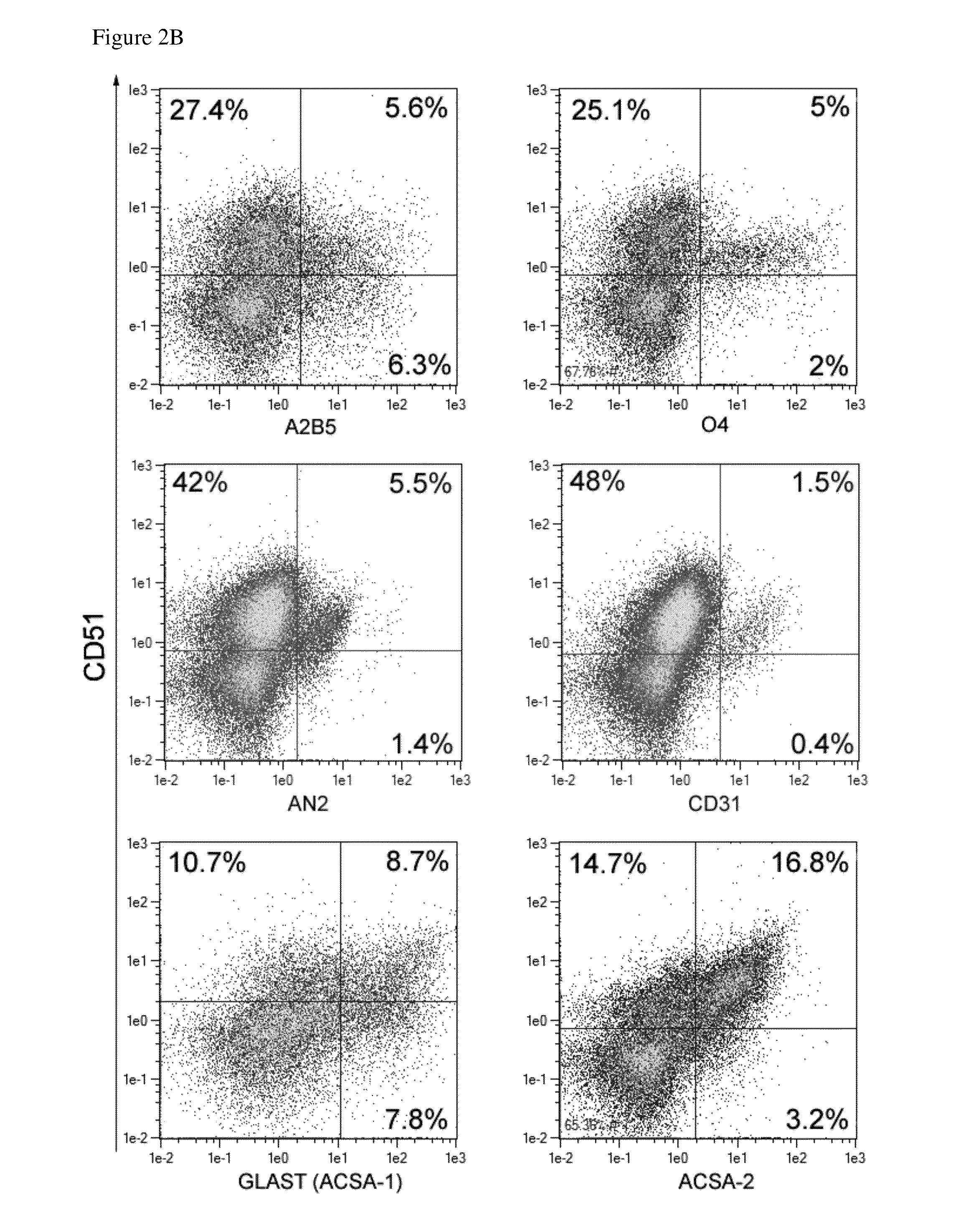Separation of living untouched neurons
a technology for separating living neurons and untouched cells, applied in the field of cells, can solve the problems of large cell loss, low purities, and lengthy procedures, and achieve the effect of increasing purities
- Summary
- Abstract
- Description
- Claims
- Application Information
AI Technical Summary
Benefits of technology
Problems solved by technology
Method used
Image
Examples
example 2
Flow Cytometric Characterization of CD51 Positive Cells in Postnatal Mouse Brain Tissue
[0089]Mouse brain tissue derived from P1, P2, or P3 CD1 mice was dissociated as described before using the NTDK(T) or (P). The resulting single cell suspension was co-stained with CD51 and markers specific for different neural subpopulations and subjected to flow cytometric analysis. For staining of the protease-sensitive epitopes CD31 and AN2, the cell suspension was incubated for 2 h at 37° C. in MACS® Neuro Medium +MACS® Supplement B27 PLUS under continuous rotation to re-express the epitopes. Due to the lack of markers that allow marking of living neuronal cell populations, GAD67-GFP transgenic mice were used to detect GABAergic neurons by their expression of GFP (green fluorescent protein). The analysis showed that GAD67-GFP positive GABAergic neurons lacked CD51 expression. Furthermore, neuronal progenitor cells, identified by PSA-NCAM expression, were identified as CD51 negative (see FIG. 2...
example 3
Depletion of CD51 Positive Cells By Magnetic Cell Separation
[0091]For depletion of CD51 positive non-neuronal cells a direct labeling strategy was compared to an indirect labeling with respect to purity and recovery of the target cells. For the direct labeling a CD51 specific antibody was covalently conjugated to magnetic particles.
[0092]The generation of superparamagnetic particles as used herein is disclosed in U.S. Pat. No. 5,543,289 which is included herewith by reference. Monoclonal antibodies recognizing the CD51 antigen were covalently conjugated to magnetic beads, resulting in 25 μg antibody per mL of bead suspension at a concentration of OD450=10.
[0093]Different concentrations of bead conjugated antibodies (0.75, 1.5, 3, 6 OD450 / ml) were given to 100 μl of a neural cell suspension containing 1×107 cells. Cells were incubated for 15 minutes at 4° C., washed once with 1 ml PBS+0.5% BSA buffer, then resuspended in 1 ml of the same buffer and loaded on an LD column placed in th...
example 4
Efficient Depletion of Non-Neuronal Cells
[0097]CD51 positive cells were depleted using whole mouse brain derived from P2 or P3 CD1 mice and an indirect labeling strategy as described before. The original, negative as well as positive cell fraction were co-stained with CD51 and exemplary A2B5, O4, GLAST (ACSA-1), ACSA-2, CD11b specific antibodies to determine the percentage of different neural subtypes in the original, negative as well as positive cell fraction. Use of GAD67-GFP mice allowed detection of GABAergic neurons. FIG. 4A shows that GAD67-GFP positive GABAergic neurons were enriched in the negative target cell fraction, whereas non-neuronal cells, like AN2 positive oligodendrocyte precursors, O4 positive oligodendrocytes, and CD11b positive microglia were depleted and found in the positive fraction (see FIGS. 4A,B). The majority of GLAST (ACSA-1) and ACSA-2 positive astrocytes was also depleted, but approximately 6% of these cells retain within the negative fraction (see FIG...
PUM
| Property | Measurement | Unit |
|---|---|---|
| concentration | aaaaa | aaaaa |
| temperature | aaaaa | aaaaa |
| pH | aaaaa | aaaaa |
Abstract
Description
Claims
Application Information
 Login to View More
Login to View More - R&D
- Intellectual Property
- Life Sciences
- Materials
- Tech Scout
- Unparalleled Data Quality
- Higher Quality Content
- 60% Fewer Hallucinations
Browse by: Latest US Patents, China's latest patents, Technical Efficacy Thesaurus, Application Domain, Technology Topic, Popular Technical Reports.
© 2025 PatSnap. All rights reserved.Legal|Privacy policy|Modern Slavery Act Transparency Statement|Sitemap|About US| Contact US: help@patsnap.com



